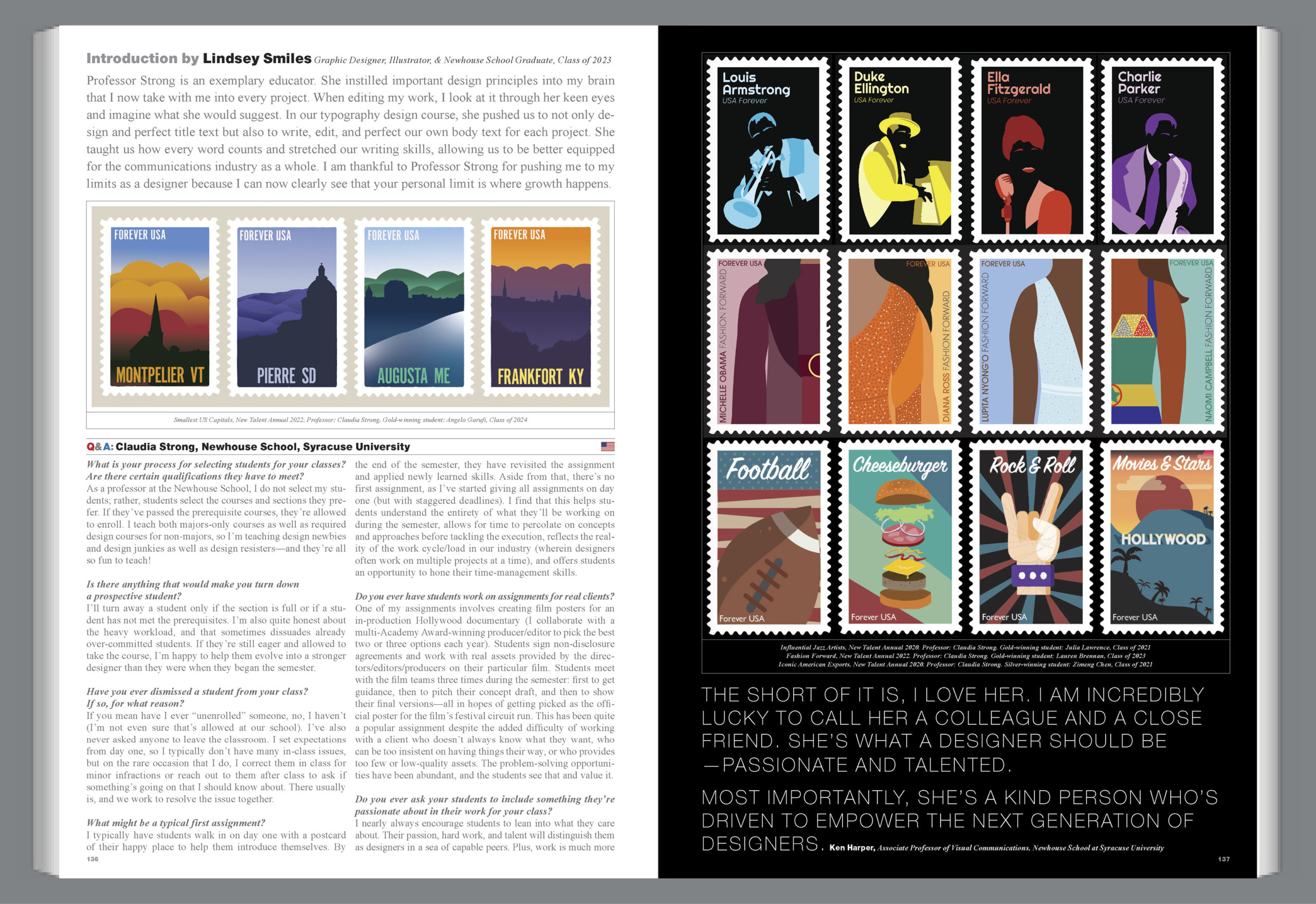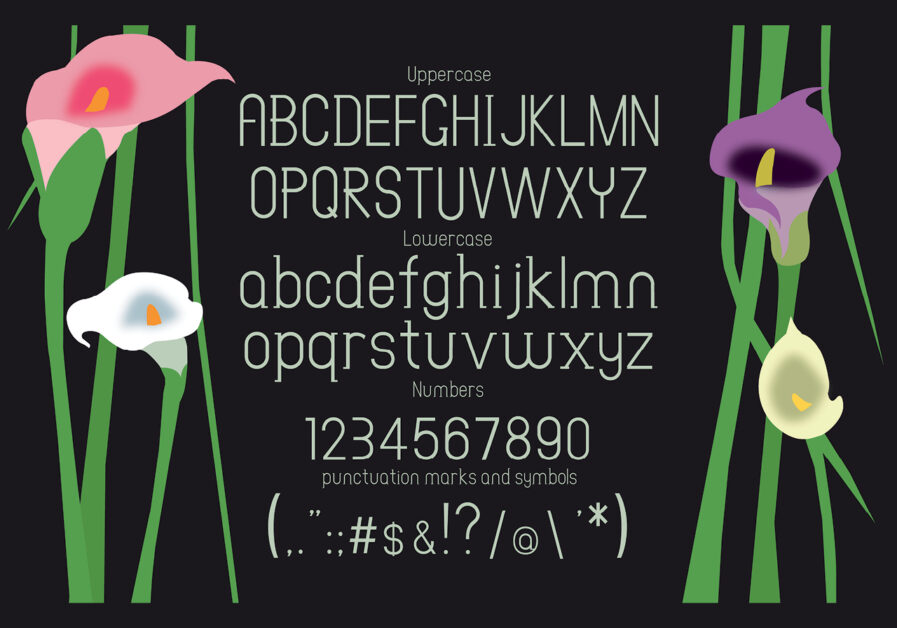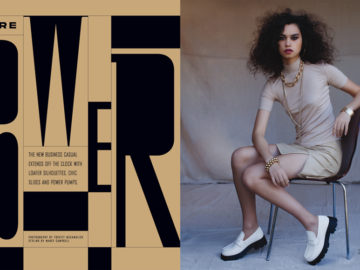At the intersection of design and writing, Claudia Strong, a distinguished professor at Syracuse University’s S.I. Newhouse School of Public Communications, has indelibly impacted her students over 17 years. Introduced by former student Lindsey Smiles, this Q&A explores Strong’s innovative teaching approach, emphasizing visual and verbal communication fusion. From collaborating on real-world projects to fostering a classroom environment that values passion, critique, and individual growth, Strong’s methodology prepares students for the complexities of the communications industry. It instills in them a profound appreciation for the power of design and words. Her dedication to education and her students’ success reflects a deep commitment to shaping the future of design and communication.
Introduction by Lindsey Smiles, Graphic Designer, Illustrator, & Newhouse School Graduate, Class of 2023
Professor Strong is an exemplary educator. She instilled important design principles into my brain that I now take with me into every project. When editing my work, I look at it through her keen eyes and imagine what she would suggest. In our typography design course, she pushed us to not only design and perfect title text but also to write, edit, and perfect our own body text for each project. She taught us how every word counts and stretched our writing skills, allowing us to be better equipped for the communications industry as a whole. I am thankful to Professor Strong for pushing me to my limits as a designer because I can now clearly see that your personal limit is where growth happens.

What is your process for selecting students for your classes? Are there certain qualifications they have to meet?
As a professor at the Newhouse School, I do not select my students; rather, students select the courses and sections they prefer. If they’ve passed the prerequisite courses, they’re allowed to enroll. I teach both majors-only courses as well as required design courses for non-majors, so I’m teaching design newbies and design junkies as well as design resisters—and they’re all so fun to teach!
Is there anything that would make you turn down a prospective student?
I’ll turn away a student only if the section is full or if a student has not met the prerequisites. I’m also quite honest about the heavy workload, and that sometimes dissuades already over-committed students. If they’re still eager and allowed to take the course, I’m happy to help them evolve into a stronger designer than they were when they began the semester.
Have you ever dismissed a student from your class? If so, for what reason?
If you mean have I ever “unenrolled” someone, no, I haven’t (I’m not even sure that’s allowed at our school). I’ve also never asked anyone to leave the classroom. I set expectations from day one, so I typically don’t have many in-class issues, but on the rare occasion that I do, I correct them in class for minor infractions or reach out to them after class to ask if something’s going on that I should know about. There usually is, and we work to resolve the issue together.
What might be a typical first assignment?
I typically have students walk in on day one with a postcard of their happy place to help them introduce themselves. By the end of the semester, they have revisited the assignment and applied newly learned skills. Aside from that, there’s no first assignment, as I’ve started giving all assignments on day one (but with staggered deadlines). I find that this helps students understand the entirety of what they’ll be working on during the semester, allows for time to percolate on concepts and approaches before tackling the execution, reflects the reality of the work cycle/load in our industry (wherein designers often work on multiple projects at a time), and offers students an opportunity to hone their time-management skills.
Do you ever have students work on assignments for real clients?
One of my assignments involves creating film posters for an in-production Hollywood documentary (I collaborate with a multi-Academy Award-winning producer/editor to pick the best two or three options each year). Students sign non-disclosure agreements and work with real assets provided by the directors/editors/producers on their particular film. Students meet with the film teams three times during the semester: first to get guidance, then to pitch their concept draft, and then to show their final versions—all in hopes of getting picked as the official poster for the film’s festival circuit run. This has been quite a popular assignment despite the added difficulty of working with a client who doesn’t always know what they want, who can be too insistent on having things their way, or who provides too few or low-quality assets. The problem-solving opportunities have been abundant, and the students see that and value it.
Do you ever ask your students to include something they’re passionate about in their work for your class?
I nearly always encourage students to lean into what they care about. Their passion, hard work, and talent will distinguish them as designers in a sea of capable peers. Plus, work is much more enjoyable and successful when a designer has a vested interest in the subject matter. I assign a basic framework, but students pick their specific topic. In our department, we also make it a habit to assign passion projects in our courses, whose topic and medium are completely up to each student, so long as they work on it for only 15-30 minutes a day for 30 days. The goal is to build a creative habit while exploring and developing a new skill.
Do you work with students individually or in groups?
We do work together in class, whether in a lecture, critique, guest speaker, or work mode, but I also work individually with any student who signs up for office hours. Sometimes, a student wants to run an idea by me—or sometimes more than one—so I can help them pick the better option. Other times, they’re stuck and can’t seem to solve an issue. In those cases, I first ask a lot of questions to help them talk out the problem. I find that they often will stumble onto a solution as they speak to me. The answer literally comes out of their mouth; all I have to do is point it out. When that strategy doesn’t work, I suggest they try the opposite of what they’re doing. If it’s big, try it small; if it’s here, try it there; if it’s black, try it white, etc. As a last resort, I suggest one or two specific steps to a possible solution. One key rule of office hours is that I don’t allow them to save any work we’ve done together, which probably has too much of me in the mix. They must retrace the steps on their own later in the process, and that means they are more likely to make it theirs.
Do you have group critiques of the students’ work?
We hold regular group critiques before final assignments are due, not only so that students might better understand what’s working and what isn’t working in their design but also so that they might learn from one another and grow as communicators. An often overlooked benefit of group critiques is that they force students to develop their critical thinking, problem-solving, and public speaking skills, all while articulating their reasoning with professionalism and empathy.
How do you develop and raise your student’s visual and verbal standards?
Visually, I show examples of only the best work (student and professional) and avoid muddying their eventual recall of the material with sub-par designs (to point out defects and poor decision-making). I also expect every student, no matter how talented or how good the work, to revise their first submission and resubmit it with their final semester’s portfolio. The work always gets better. Verbally, my students are in for a bit of a shock. I’m a former journalist, and my happy place is at the corner of words and design, so I emphasize and require writing with every assignment, not only to accompany the design itself in the form of an explainer or marketing copy but also in the extensive rationale each student must submit with every project. Usually, a thorough rationale is at least two pages, single-spaced, though sometimes I’ll get up to five or six. The quality of the thinking and writing on these rationales also factors into the project grade. I dedicate one class lecture to writing and editing.
What percentage of a typical class goes on to create award-winning work?
I don’t have data on this, so it’s tough to answer, but I can tell you that the majority of our design majors from the past two years won some sort of accolade—from gold to award of excellence—from the Graphis New Talent competition for work they produced in my Typographic Design course. I believe we had 22 awards in 2021 and 30 in 2022, which was the last time I taught Typographic Design (I’ll resume next fall).
At the end of the semester, what kind of advice do you give the class?
At the end of the semester, during our final presentation, I ask students to tell me what lessons were most valuable and what design truths they’ll remember from my course five years from now. After revisiting a few key lessons (and laughing a good bit along the way, mostly at my expense), I put up one final quote about the beauty, power, and reality of design, as well as some encouragement from me: “Design creates culture. Culture shapes values. Values determine the future.” Now go and design the future. 
Can you name a few of your past students who have gained success? If so, what are they doing now?
I believe most of our design graduates go on to have fulfilling and fruitful careers in the industry, so from my perspective, they’re all successful. That said, Kevin Camelo (’21) is a visual designer at IBM, Jordana Rubin (’17) is a digital designer at Sony Music Entertainment, Jane Depgen (’15) is a senior UX designer at Amazon, and Chris Azar (’12) is a senior design manager at Adobe.
What do you think of the way so many people in the creative fields now are without any formal, never mind university level, training?
There’s certainly value in learning from others and dedicating oneself formally to the study and practice of a particular subject, but does this mean it’s the only way to become a successful, effective designer? Certainly not. I’m sure some self-taught designers are quite capable and will do very well, and I’m equally sure others are not at all capable and will not do very well. The same is true in university classrooms—some will do well, others will not. For my part, I didn’t study design in school but fell into it at my first job. Our art director, a formally trained designer, told me that I was a natural at design, and she encouraged me to pursue it where I was. I listened to her and never looked back. She and many others nurtured me along the way, and now it’s my chance to do the same, regardless of a designer’s pedigree.
Claudia Strong teaches various graphic design and writing courses to graduate and undergraduate students at Syracuse University’s S.I. Newhouse School of Public Communications, where she’s worked for 17 years. There, she also helps organize and lead major annual workshops, curates annual student exhibits, and contributes to the global photographic community via The Alexia grants as a faculty consultant. Claudia, who began her career as a journalist and is originally from Chile, was honored with a Newhouse Excellence in Teaching award in 2023, the award’s inaugural year.






